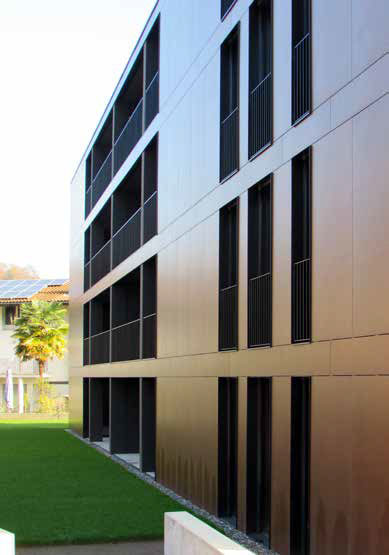When creating an architectural project that is as welcoming as possible, it is important to place the proper emphasis on factors such as aesthetics, acoustic and thermal comfort, and last but not least in terms of importance, the limiting of energy consumption. How can ceramic material intervene in the field of design to optimize all these factors?
Through ventilated facades. These actually allow the building to be clad in a new skin, and at the same time, to valorise the aforementioned aesthetic and technical characteristics. This system leaves plenty of freedom of expression for the architect, who can decorate facades with different colours, formats and graphics, to create styles that are always different and unique. For example, the multiple formats of porcelain stoneware available on the market allow the designer to create genuine patchworks to bestow movement on the whole.
In the event, though, that the same format is preferred, creativity knows no bounds. Corteneffect slabs, for example, depict the different phases of metallic oxidation: hence, with the same format and the same effect, it is possible to create a vibrant, multi-coloured wall that is always different.
For a project in a mountain setting or one for which a “natural stone” effect is preferred, the technology in the ceramic field has reached such high levels that it is now possible to produce slabs – even in large and extralarge formats – that perfectly reproduce the nuances and natural characteristics of stone. In this case, too, it is possible to use slabs of the same format, but which offer different graphic solutions, thus achieving noteworthy results in terms of beauty and naturalness.
For designers who favour a lively effect and real movement, there is a vast assortment of threedimensional stoneware to choose from: the texture of the material allows you to create vibrant effects, which are very suited to contemporary architectural demands.
On the other hand, if ceramic material without any particular effect is preferred, the end result will by no means be banal: ceramic cladding actually changes on the basis of the light. Its colours adapt to the seasons and to the changing times of the day, hence creating a dynamic and ever-changing project, despite its immutability.
Story by Cristina Bigliatti
Photo (from top to bottom):
Cascina-Merlata, Milano, Italy | Marazzi
Residential Complex, Agno, Switzerland | Casamood
Malpensa Airport, Milano, Italy | Caesar (left)
Hotel Petronio, Riccione, Italy | Ceramiche Refin (right)
I Giardini Di Gabriel, Asnières-Sur-Seine, France | Casalgrande Padana
Gongpyong Office Plaza A Seoul, South Korea | Laminam







